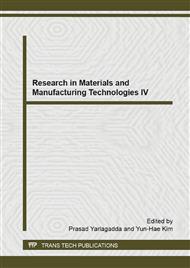p.61
p.65
p.71
p.79
p.83
p.87
p.91
p.96
p.100
Effects of Different Sintering Temperature on the Microstructure and Piezoelectric Properties of Pb(Nb2/3Zn1/3)x(Zr52Ti48)1-XO3 Ceramics
Abstract:
In this paper, the effects of different sintering temperature on the microstructure and piezoelectric properties of Pb(Nb2/3Zn1/3)0.03(Zr52Ti48)0.97O3(PNZZT) ceramic samples were investigated. The Pb(Nb2/3Zn1/3)0.03(Zr52Ti48)0.97O3 ceramics materials was prepared by a conventional mixed oxide method. In the period of the experiment, the relationship between crystallographic phase and microstructure were analyzed by X-ray diffraction(XRD) and scanning electron microscopy(SEM) respectively. The XRD patterns shows that all of the ceramic samples are with a tetragonal perovskite structure. Along with sintering temperature increased and the x is 0.03, the grain size gradually become big. Through this experiment, it has been found that when the x is 0.03 and sintered at 1130°C for 2 h, the grains grow well, the grain-boundary intersection of the sample combined well and the porosity of the ceramics decreased, an excellent comprehensive electrical properties of the Pb(Nb2/3Zn1/3)0.03(Zr52Ti48)0.97O3 samples can be obtained. Its best electrical properties are as follows: dielectric constant (ε) is 1105, dielectric loss(tg) is 0.017, electromechanical coupling coefficient (Kp) is 0.287, piezoelectric constant(d33) is 150PC/N
Info:
Periodical:
Pages:
83-86
Citation:
Online since:
December 2014
Authors:
Keywords:
Price:
Сopyright:
© 2015 Trans Tech Publications Ltd. All Rights Reserved
Share:
Citation:


